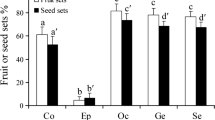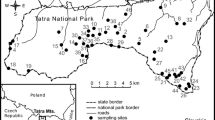Abstract
Small changes in morphology can affect the performance and functions of organisms and hence their ecological success. In modular constructed plants, contrasting growth strategies may be realized by differences in the spatial arrangement and size of shoots. Such differences change the way in which meristems and resources are assigned to various functions during the lifespan of a plant. If such changes include the capacity to spread clonally, sexual reproduction may also be affected. I compare patterns in vegetative growth and sexual reproductive traits in four allopatric species ofEpilobium which are sometimes considered as subspecies of a single polymorphic taxon. The four species differ in the location of the buds which annually renew the aerial shoot system.E. dodonaei andE. steveni do not spread clonally and are characterized by a shrub-like habit.E. fleischeri, a species occurring only in the Alps, andE. colchicum, which occurs in the upper region of the Caucasus mountains, both produce buds on horizontal roots or plagiotropic shoots. Both alpine species exhibiting clonal growth have smaller shoots, fewer fruits and smaller seeds than the lowland species. An intraspecific trade-off between seed number per fruit and seed mass is realized. Both alpine species produce more seeds per fruit at the expense of seed mass. The morphological relationship between the four species and their geographical distribution suggest that clonal growth inE. fleischeri (restricted to the Alps) andE. colchicum (restricted to the Caucasus) is adaptively associated with the stressful conditions of alpine habitats. Our results suggest that clonal growth is not necessarily correlated with reduced reproduction by seeds. The success of plants which are already established may largely depend on clonal spread, but the colonization of new habitats depends on the production of a large number of small seeds with high dispersability.
Similar content being viewed by others
References
Abrahamson W.G. (1980): Demography and vegetative reproduction. In:Solbrig O.T. (ed.),Demography and evolution in plant populations, Blackwell Sci. Publ., Oxford, pp. 89–106.
Callaghan T.V. (1988): Physiological and demographic implications of modular construction in cold environments. In:Davy A.H. et al. (eds.),Population biology of plants, Blackwell, Oxford, pp. 111–135.
Callaghan T.V. &Emanuelsson U. (1985): Population structure and processes of tundra plants and vegetation. In:White J. (ed.),The population structure of vegetation, Junk Publishers, Dordrecht, pp. 399–439.
de Kroon H. &Schieving F. (1990): Resource partitioning in relation to clonal growth strategy. In:van Groenendael J. &de Kroon H. (eds.),Clonal growth in plants: Regulation and function, Academic Publishing, The Hague, pp. 113–130.
Eriksson O. (1992): Evolution of seed dispersal and recruitment in clonal plants.Oikos 63: 439–453.
Eriksson O. (1997): Clonal life histories and the evolution of seed recruitment. In:de Kroon H. &van Groenendael J. (eds.),The ecology and evolution in clonal plants, Backhuys Publishers, The Netherlands, pp. 211–226.
Harper J.L. (1978): The demography of plants with clonal growth. In:Freysen A.H.J. &Woldendorp J.W. (eds.),Structure and functioning of plant populations, North Holland Publishing Company, Amsterdam, pp. 27–48.
Harper J.L. & Bell A.D. (1979): The population dynamics of growth form in organisms with modular construction. In: Anderson R.M. et al. (eds.), Population dynamics, 20th Symposium of the British Ecol. Soc., Blackwell, London, pp. 29–52.
Hartmann H. (1955):Studien über die vegetative Fortpflanzung in den Hochalpen. PhD Thesis, Universität Zürich, Zürich.
Haussknecht C. (1884):Monographie der Gattung Epilobium. Jena.
Hutchings M.J. &Mogie M. (1990): The spatial structure of clonal plants: control and consequences. In:van Groenendael J. &de Kroon H. (eds.),Clonal growth in plants: Regulation and function, Academic Publishing, The Hague, pp. 57–76.
Jochimsen M. (1970): Die Vegetationsentwicklung auf Moränenböden in Abhängigkeit von einigen Umweltfaktoren.Veröff. Univ. Innsbruck 46: 5–22
Klimeš L., Klimešová J., Hendriks R. &van Groenendael J. (1997): Clonal plant architecture: a comparative analysis of form and function. In:de Kroon H. &van Groenendael J. (eds.),The ecology and evolution in clonal plants, Backhuys Publishers, The Netherlands, pp. 1–29.
Lloyd D.G. (1987): Selection of offspring size at independence and other size-versus number strategies.Amer. Naturalist 129: 800–817.
Lovett Doust L. &Lovett Doust J. (1982): The battle strategies of plants.New Sci. 8: 81–84.
Matthews J.A. (1992):The ecology of recently deglaciated terrain. Cambridge studies in ecology, Cambridge University Press, Cambridge.
Meusel H., Jäger E. & Weinert E. (1965):Vergleichende Chorologie der zentraleuropäischen Flora. Fischer, Jena.
Payne R.W. (1993):GENSTAT 5 reference manual. Clarendon Press, Oxford.
Rauh W. (1937): Die Bildung von Hypocotyl- und Wurzelsprossen und ihre Bedeutung für die Wuchsformen der Pflanzen.Nova Acta Leop. 24: 345–555.
Raven P.H. (1962): The genusEpilobium in Turkey.Notes Roy. Bot. Gard. Edinburgh 24: 184–203.
Raven P.H. (1976): Generic and sectional delimitation inOnagraceae, tribeEpilobieae.Ann. Missouri Bot. Gard. 63: 326–340.
Rees M. (1993): Trade-offs among dispersal strategies in British plants.Nature 366: 150–152.
Sackville Hamilton N.R., Schmid B. &Harper J.L. (1987): Life history concepts and the population biology of clonal organisms.Proc. Roy. Soc. London B 232: 35–57.
Schaffer W.M. &Gadgil M.D. (1975): Selection for optimal life histories in plants. In:Cody M.L. &Diamond J. (eds.),Ecology and evolution in communities, Belknap Press, Cambridge, pp. 142–156.
Schinz H. & Keller R. (1923):Flora der Schweiz. Ed. 4. Zürich.
Shipley B. &Dion J. (1992): The allometry of seed production in herbaceous angiosperms.Amer. Naturalist 139: 467–483.
Shishkin B.K. & Bobrov E.G. (eds.) (1974):Flora of the U.S.R.R. 15. Israel Program for Scientific Translations, Jerusalem.
Söyrinki N. (1938): Studien über die generative und vegetative Vermehrung der Samenpflanzen in der alpinen Vegetation Petsamo-Lapplands. I. Allgemeiner Teil.Ann. Bot. Soc. Zool. Bot. Fenn. Vanamo 11: 83–89, 124–147.
Stöcklin J. (1990): Populationsstruktur des RohbodenpioniersEpilobium fleischeri Hochst. auf dem Morteratsch-Gletschervorfeld.Verh. Ges. Ökol. 19: 30–43.
Stöcklin J. (1992): Differences in the location of subcotyledonary buds amongEpilobium angustifolium L.,E. dodonaei Vill. andE. fleischeri Hochst. (Onagraceae) and effects on architecture and population structure.Bot. J. Linn. Soc. 108: 35–47.
Stöcklin J. &Bäumler E. (1996): Seed rain, seedling establishment and clonal growth strategies on a glacier foreland.J. Veg. Sci. 7: 45–56.
Stöcklin J. &Favre P. (1994): Effects of plant size and morphological constraints on variation in reproductive components in two related species ofEpilobium.J. Ecol. 82: 735–747.
Sutherland S. &Vickery R.K. (1988): Trade-offs between sexual and asexual reproduction in the genusMimulus.Oecologia 76: 330–335.
Theurillat J.-P. (1979): Etude biosystématique d’Epilobium dodonaei Vill. et d’E. fleischeri Hochst. (Onagraceae).Bull. Soc. Neuchâteloise Sci. Nat. 102: 105–128.
Tiffney B.H. &Niklas K.J. (1985): Clonal growth in land plants: a palaeobotanical perspective. In:Jackson J.B., Buss L.W. &Cook R.E. (eds.),Population biology and evolution of clonal organisms, Yale Univ. Press, New Haven, pp. 35–66.
Tutin T.G. et al. (eds.) (1968):Flora europaea 2. Cambridge University Press, Cambridge.
Urbanska K.M. &Schütz M. (1968): Reproduction by seed in alpine plants and revegetation research above timberline.Bot. Helv. 96: 43–60.
van Andel J. (1975): A study on the population dynamics of the perennial plant speciesChamaenerion angustifolium (L.) Scop.Oecologia 19: 329–337.
Waller D.M. (1988): Plant morphology and reproduction. In:Lovett Doust J. &Lovett Doust L. (eds.),Plant reproductive ecology, Oxford University Press, New York, pp. 203–227.
Watson M.A. (1984): Development constraints: effect on population growth and patterns of resource allocation in a clonal plant.Amer. Naturalist 12: 411–426.
Watson M.A. &Casper B.B. (1984): Morphogenetic constraints on patterns of carbon distribution in plants.Annual Rev. Ecol. Syst. 15: 233–258.
Westoby M., Jurado E. &Leishmann M. (1992): Comparative evolutionary ecology of seed size.Trends Ecol. Evol. 7: 368–372.
Author information
Authors and Affiliations
Corresponding author
Rights and permissions
About this article
Cite this article
Stöcklin, J. Differences in life history traits of relatedEpilobium species: Clonality, seed size and seed number. Folia Geobot 34, 7–18 (1999). https://doi.org/10.1007/BF02803073
Issue Date:
DOI: https://doi.org/10.1007/BF02803073




